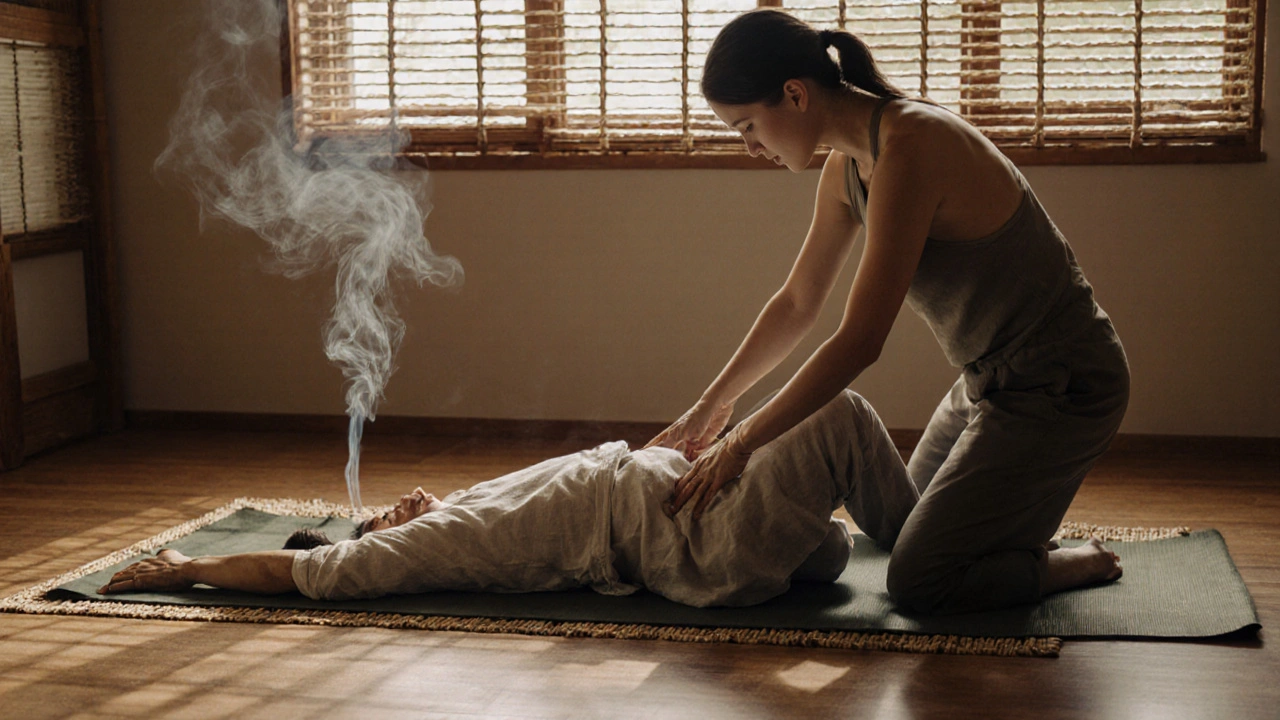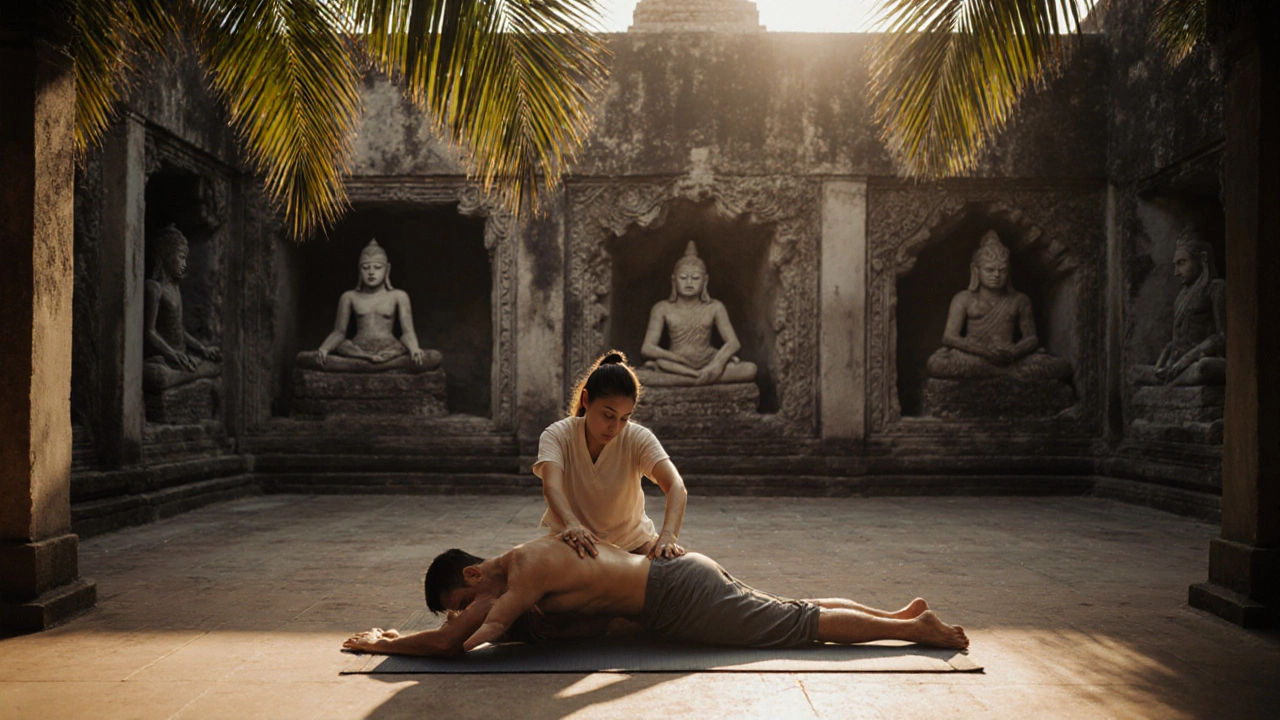You’ve been rolling out your mat every morning, holding poses longer, breathing deeper. But lately, your hamstrings feel tight, your hips won’t open, and your shoulders scream after downward dog. You’re doing everything right-except maybe one thing: Thai massage.
Thai massage isn’t just another spa treat. It’s a 2,500-year-old system that blends acupressure, assisted yoga postures, and deep stretching. And if you’re serious about your yoga practice, it’s the missing piece you didn’t know you needed.
Why Thai Massage Works for Yogis
Think of your body as a rope. Yoga stretches it. Thai massage untangles it.
When you hold a pose like pigeon or forward fold, your muscles are working hard-but they’re also holding onto tension you didn’t even realize was there. That’s where Thai massage steps in. A practitioner doesn’t just press on your back or squeeze your calves. They use their hands, thumbs, elbows, knees, and even feet to guide your body through a series of passive yoga-like stretches.
It’s not about relaxation alone. It’s about releasing deep fascial restrictions, resetting muscle length, and improving joint mobility. A 2023 study in the Journal of Bodywork and Movement Therapies found that participants who received weekly Thai massage for six weeks improved hip flexion by 22% and spinal extension by 18%-without doing a single extra yoga pose.
That’s the secret: Thai massage helps you get deeper into poses not by forcing them, but by removing the blocks holding you back.
How Thai Massage Complements Your Yoga Routine
Yoga builds strength and awareness. Thai massage removes the physical barriers to deeper movement.
Let’s say you struggle with seated forward folds. Your hamstrings feel like steel cables. You stretch every day. You breathe into it. You still can’t reach your toes.
Now imagine a Thai massage therapist gently guiding your legs into a passive stretch, applying rhythmic pressure along your hamstrings, then slowly rocking your pelvis to release the connection between your glutes and lower back. After 45 minutes, you feel lighter. Your body remembers what it’s like to be flexible.
That’s not magic. It’s biomechanics.
Thai massage targets the sen lines-energy pathways similar to meridians in traditional Chinese medicine. These lines run through muscles, tendons, and connective tissue. When they’re blocked, movement suffers. Thai massage clears those blockages, making your yoga practice feel smoother, deeper, and less like a battle.
What Happens During a Thai Massage Session
You lie on a mat on the floor, fully clothed in loose, comfortable clothes. No oil. No nudity. Just you, the therapist, and a quiet room.
The session starts with gentle pressure on your feet and legs-like a slow, rhythmic massage that wakes up your nervous system. Then comes the stretching: your arms are pulled into overhead positions, your spine is gently twisted, your hips are opened with careful pressure from the therapist’s knee.
It’s not always comfortable. Some moves feel intense. But it shouldn’t hurt. If it does, speak up. A good therapist adjusts on the fly.
By the end, you’re not just relaxed-you feel rearranged. Like your bones have shifted slightly into better alignment. Your breath flows deeper. Your shoulders drop. Your hips feel open for the first time in months.
When to Schedule Thai Massage Around Your Yoga Practice
You don’t need to do it every day. Timing matters.
- After intense yoga sessions: Use Thai massage to flush out lactic acid and prevent stiffness. It’s like a reset button for overworked muscles.
- Before a yoga retreat or workshop: Get a session 1-2 days before. Your body will be more pliable, and you’ll get more out of advanced classes.
- On rest days: Skip the foam roller. Book a Thai massage instead. It’s active recovery that actually works.
- When you hit a plateau: If your poses haven’t improved in weeks, your body might be holding tension you can’t release on your own. Thai massage breaks through that.
Most yogis find that one session every 2-4 weeks keeps their flexibility moving forward. Some do it weekly during intense training periods.

Thai Massage vs. Other Recovery Methods
Let’s compare Thai massage to other common recovery tools yogis use.
| Method | Best For | Duration of Effect | Requires Active Effort? | Deep Tissue Release? |
|---|---|---|---|---|
| Thai Massage | Flexibility, joint mobility, energy flow | 3-7 days | No | Yes |
| Yoga Stretching | Strength, mindfulness, control | 1-3 days | Yes | Moderate |
| Foam Rolling | Myofascial release, surface tension | 1-2 days | Yes | Light |
| Swedish Massage | Relaxation, circulation | 1-2 days | No | No |
| Static Stretching | Mild flexibility gains | Hours | Yes | Minimal |
Thai massage stands out because it’s the only method that combines deep physical release with the structure of yoga poses-without you having to do a single stretch yourself.
Where to Find Authentic Thai Massage
Not all "Thai massage" is created equal. Some places just call it Thai massage to sound exotic. Real Thai massage comes from trained practitioners who understand the sen lines and traditional techniques.
Look for these signs:
- The therapist uses their body weight-not just hands-to apply pressure.
- You’re fully clothed. No oils or sheets.
- The session takes place on a floor mat, not a table.
- The therapist asks about your yoga practice and adjusts the session accordingly.
- They mention sen lines or traditional Thai healing concepts.
Many yoga studios now offer Thai massage as an add-on. Check with your local studio. If they don’t, ask if they can recommend a certified Thai massage therapist. Look for schools like the Wat Pho Thai Massage School in Bangkok-many certified teachers train abroad now.
What to Expect to Pay
Prices vary by city and experience level.
- $50-$70 for a 60-minute session at a wellness center or yoga studio.
- $80-$120 for a 90-minute session with a master therapist or certified instructor.
- $150+ for private sessions in high-end spas (often overpriced unless the therapist has direct lineage from Thailand).
Don’t chase the cheapest option. A poorly trained therapist can push too hard or misalign your joints. Look for reviews that mention "yoga-friendly" or "deep but respectful"-those are the ones who know what they’re doing.

Safety Tips for Yogis
Thai massage is safe for most people-but not if you ignore your limits.
- Don’t go in with acute injuries: If you have a recent hamstring tear or spinal issue, wait until you’re healed.
- Communicate: Say "slower," "less pressure," or "stop" if anything feels wrong. You’re in control.
- Hydrate after: Your body releases toxins during deep tissue work. Drink water to flush them out.
- Avoid right before yoga: Wait at least 4 hours. Your body needs time to integrate the release.
- Listen to your body: If you feel dizzy, nauseous, or overly sore the next day, you went too deep. Next time, ask for lighter pressure.
Real Stories: Yogis Who Transformed Their Practice
Sarah, a 38-year-old yoga teacher from Portland, struggled with tight hips for 10 years. She could barely do lotus pose. After six Thai massage sessions over three months, she finally sat in lotus without pain. "It felt like my body remembered how to open," she said.
Mark, a 45-year-old runner who took up yoga for recovery, couldn’t touch his toes. After two Thai massage sessions, he could reach his ankles. "I didn’t stretch more. I just stopped fighting my body. That’s the difference."
Frequently Asked Questions
Can Thai massage help with yoga injuries?
Yes-but only for chronic tension or stiffness, not acute injuries. Thai massage helps restore mobility after strains or overuse, but never use it on a fresh sprain or torn muscle. Always consult a physical therapist first if you’re unsure.
Do I need to be flexible to try Thai massage?
No. In fact, Thai massage is perfect for people who aren’t flexible. The therapist moves you gently into positions your body can handle. You’re not expected to do anything. It’s passive healing.
Is Thai massage the same as yoga therapy?
They’re related but different. Yoga therapy involves you actively practicing poses with guidance. Thai massage is a hands-on treatment where the therapist moves you. Think of Thai massage as a deep-tissue yoga session done for you.
How often should I get Thai massage if I do yoga daily?
Once every 2-4 weeks is ideal for most people. If you’re training for a retreat or competition, once a week for a month can reset your body quickly. After that, go back to maintenance mode.
Can I do Thai massage at home?
You can’t fully replicate it alone. But you can use a yoga strap and foam roller to mimic some stretches. For true Thai massage benefits, you need another person to apply pressure and guide your body safely. It’s not a DIY technique.
Ready to Move Deeper Into Your Practice?
You don’t have to keep fighting your body to get into poses. The flexibility you’re chasing isn’t about strength-it’s about release. Thai massage doesn’t ask you to try harder. It helps your body remember how to let go.
Book your first session. Tell the therapist you’re a yogi. Let them tailor the session to your tight spots. Come back in a few weeks. Then come back again. Your mat will thank you.









Zakaria SANKARA
November 7, 2025 AT 06:03Thai massage? More like Thai scam. You paying $120 for someone to pull your legs while whispering ‘sen lines’ like it’s magic dust. My cousin in Bangkok did this for $10 and lived to tell about it.
Julie Corbett
November 8, 2025 AT 09:41Oh, absolutely. The ‘sen lines’-those mystical energy channels only accessible to those who’ve read the ancient scrolls translated by monks who never left Chiang Mai. I mean, really. How many of us have been held back by invisible bioenergetic knots? I’ve been practicing for 12 years and only last month did I realize my tight hips were a karmic blockage. Thai massage didn’t just stretch me-it realigned my chakras. I cried. It was profound.
Kirsten Stubbs
November 8, 2025 AT 15:37Stop promoting pseudoscience. There’s no such thing as ‘sen lines.’ That’s just Thai people making up myths to charge more. And ‘passive yoga’? That’s not yoga-that’s being manhandled by a stranger in a room with incense. You’re not ‘releasing tension’-you’re getting your joints popped like a bag of chips.
Vaishnavi Agarwal
November 10, 2025 AT 00:36How can you, as a modern yogi, be so blind? This is not about flexibility-it’s about spiritual surrender. In India, we’ve known for centuries that the body is a temple, and to force it is to disrespect the divine. Thai massage? It’s not therapy-it’s a sacred ritual. You must approach it with humility, not with your phone in hand snapping photos for Instagram. I wept after my first session. My soul felt clean.
Sara Roberts
November 10, 2025 AT 07:25so i tried this thing and my back felt like it got a hug from a ghost. no joke. i dont even know what sen lines are but my hamstrings arent screaming anymore. weird but good.
Terrance Bianco
November 11, 2025 AT 00:45You know, the whole concept of Thai massage being ‘ancient’ is just a marketing tool created by Western wellness capitalists to sell $120 sessions to people who’ve internalized the idea that pain equals progress. But think deeper-why do we believe that only someone else can release our tension? Why can’t we, as conscious beings, learn to soften ourselves? Is it fear? Is it laziness? Or is it the capitalist machine telling us that healing must be commodified, packaged, and sold with sandalwood incense? The real question isn’t whether Thai massage works-it’s why we’ve outsourced our own healing to strangers in linen pants.
William Kramer
November 12, 2025 AT 00:14Hey everyone-just wanted to say I tried this after reading the post and it was honestly life-changing. I’ve been doing yoga for 8 years and never felt this open in my hips. The therapist asked about my practice, adjusted everything, and didn’t even charge me the full rate because I mentioned I’m a teacher. It felt like someone finally understood my body. Seriously, if you’re stuck, give it a shot. No hype, just results.
Summer Perkins
November 13, 2025 AT 03:07I’m curious-has anyone tried combining Thai massage with myofascial release tools like the lacrosse ball? I did it after my session and the effects lasted longer. Not sure if it’s placebo, but my thoracic spine hasn’t felt this loose since college. Also, does anyone know if the Wat Pho certification is actually regulated, or is it just a certificate you can buy online?
Gerald Matlakala
November 13, 2025 AT 07:33Wait… so you’re telling me that a ‘Thai massage therapist’-who may or may not be connected to a shadow network of ex-military monks trained in Bangkok’s underground healing circles-is secretly manipulating your nervous system to make you more flexible? And you’re just… accepting this? Have you considered that this is all part of a larger agenda? The WHO has quietly classified Thai massage as a ‘non-regulated neuromuscular modulation technique’ since 2019. They don’t want you to know that your flexibility is being weaponized to make you more compliant in corporate yoga studios. I’ve seen the documents. They’re hidden in the footnotes.